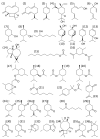Plants of Genus Mentha: From Farm to Food Factory
- PMID: 30181483
- PMCID: PMC6161068
- DOI: 10.3390/plants7030070
Plants of Genus Mentha: From Farm to Food Factory
Abstract
Genus Mentha, a member of Lamiaceae family, encompasses a series of species used on an industrial scale and with a well-described and developed culture process. Extracts of this genus are traditionally used as foods and are highly valued due to the presence of significant amounts of antioxidant phenolic compounds. Many essential oil chemotypes show distinct aromatic flavor conferred by different terpene proportions. Mint extracts and their derived essential oils exert notable effects against a broad spectrum of bacteria, fungi or yeasts, tested both in vitro or in various food matrices. Their chemical compositions are well-known, which suggest and even prompt their safe use. In this review, genus Mentha plant cultivation, phytochemical analysis and even antimicrobial activity are carefully described. Also, in consideration of its natural origin, antioxidant and antimicrobial properties, a special emphasis was given to mint-derived products as an interesting alternative to artificial preservatives towards establishing a wide range of applications for shelf-life extension of food ingredients and even foodstuffs. Mentha cultivation techniques markedly influence its phytochemical composition. Both extracts and essential oils display a broad spectrum of activity, closely related to its phytochemical composition. Therefore, industrial implementation of genus Mentha depends on its efficacy, safety and neutral taste.
Keywords: Mentha genus; antimicrobials; chemotypes; culture conditions; essential oil; food preservatives; plant extracts.
Conflict of interest statement
The authors declare no conflict of interest.
Figures

Similar articles
-
Impact of induced mutation-derived genetic variability, genotype and varieties for quantitative and qualitative traits in Mentha species.Int J Radiat Biol. 2024;100(2):151-160. doi: 10.1080/09553002.2023.2263595. Epub 2024 Jan 29. Int J Radiat Biol. 2024. PMID: 37755121 Review.
-
Prospective of Essential Oils of the Genus Mentha as Biopesticides: A Review.Front Plant Sci. 2018 Sep 10;9:1295. doi: 10.3389/fpls.2018.01295. eCollection 2018. Front Plant Sci. 2018. PMID: 30250476 Free PMC article. Review.
-
A Comprehensive Review of the Key Characteristics of the Genus Mentha, Natural Compounds and Biotechnological Approaches for the Production of Secondary Metabolites.Iran J Biotechnol. 2023 Oct 1;21(4):e3605. doi: 10.30498/ijb.2023.380485.3605. eCollection 2023 Oct. Iran J Biotechnol. 2023. PMID: 38269203 Free PMC article. Review.
-
Mentha L. species (Lamiaceae) as promising sources of bioactive secondary metabolites.Curr Pharm Des. 2008;14(29):3141-50. doi: 10.2174/138161208786404245. Curr Pharm Des. 2008. PMID: 19075696 Review.
-
Evaluation of the possible use of genus Mentha derived essential oils in the prevention of SENLAT syndrome caused by Rickettsia slovaca.J Ethnopharmacol. 2019 Mar 25;232:55-61. doi: 10.1016/j.jep.2018.12.005. Epub 2018 Dec 6. J Ethnopharmacol. 2019. PMID: 30529423
Cited by
-
Mentha piperita: Essential Oil and Extracts, Their Biological Activities, and Perspectives on the Development of New Medicinal and Cosmetic Products.Molecules. 2023 Nov 6;28(21):7444. doi: 10.3390/molecules28217444. Molecules. 2023. PMID: 37959863 Free PMC article. Review.
-
Effect-Directed, Chemical and Taxonomic Profiling of Peppermint Proprietary Varieties and Corresponding Leaf Extracts.Antioxidants (Basel). 2023 Feb 14;12(2):476. doi: 10.3390/antiox12020476. Antioxidants (Basel). 2023. PMID: 36830034 Free PMC article.
-
The metabolomic analysis of five Mentha species: cytotoxicity, anti-Helicobacter assessment, and the development of polymeric micelles for enhancing the anti-Helicobacter activity.RSC Adv. 2021 Feb 12;11(13):7318-7330. doi: 10.1039/d0ra09334c. eCollection 2021 Feb 10. RSC Adv. 2021. PMID: 35423273 Free PMC article.
-
Unveiling physiological responses and modulated accumulation patterns of specialized metabolites in Mentha rotundifolia acclimated to sub-tropical environment.Physiol Mol Biol Plants. 2024 Aug;30(8):1363-1381. doi: 10.1007/s12298-024-01489-8. Epub 2024 Jul 19. Physiol Mol Biol Plants. 2024. PMID: 39184553 Free PMC article.
-
Mentha spp. Essential Oils: A Potential Toxic Fumigant with Inhibition of Acetylcholinesterase Activity on Reticulitermes dabieshanensis.Plants (Basel). 2023 Nov 30;12(23):4034. doi: 10.3390/plants12234034. Plants (Basel). 2023. PMID: 38068668 Free PMC article.
References
-
- Sharifi-Rad J., Tayeboon G.S., Niknam F., Sharifi-Rad M., Mohajeri M., Salehi B., Iriti M., Sharifi-Rad M. Veronica persica poir. Extract-antibacterial, antifungal and scolicidal activities, and inhibitory potential on acetylcholinesterase, tyrosinase, lipoxygenase and xanthine oxidase. Cell. Mol. Biol. (Noisy-le-Grand France) 2018;64:50–56. doi: 10.14715/cmb/2018.64.8.8. - DOI - PubMed
-
- Sharifi-Rad J., Ayatollahi S.A., Varoni E.M., Salehi B., Kobarfard F., Sharifi-Rad M., Iriti M., Sharifi-Rad M. Chemical composition and functional properties of essential oils from Nepeta schiraziana Boiss. Farmacia. 2017;65:802–812.
-
- Sharifi-Rad M., Nazaruk J., Polito L., Morais-Braga M.F.B., Rocha J.E., Coutinho H.D.M., Salehi B., Tabanelli G., Montanari C., del Mar Contreras M. Matricaria genus as a source of antimicrobial agents: From farm to pharmacy and food applications. Microbiol. Res. 2018;215:76–88. doi: 10.1016/j.micres.2018.06.010. - DOI - PubMed
-
- Mishra A.P., Saklani S., Salehi B., Parcha V., Sharifi-Rad M., Milella L., Iriti M., Sharifi-Rad J., Srivastava M. Satyrium nepalense, a high altitude medicinal orchid of indian himalayan region: Chemical profile and biological activities of tuber extracts. Cell. Mol. Biol. (Noisy-le-Grand France) 2018;64:35–43. doi: 10.14715/cmb/2018.64.8.6. - DOI - PubMed
Publication types
LinkOut - more resources
Full Text Sources
Other Literature Sources

